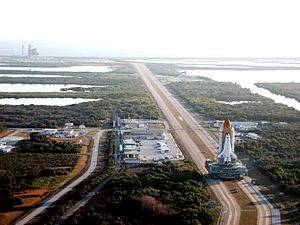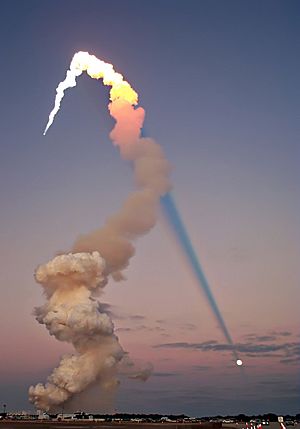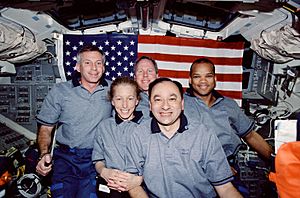STS-98 facts for kids
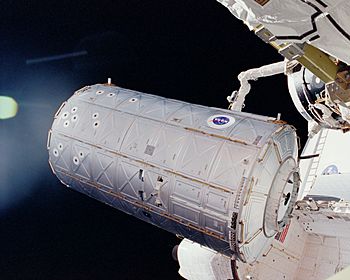
Atlantis' Canadarm grapples Destiny, prior to the module's installation on the ISS
|
|
| Mission type | ISS assembly |
|---|---|
| Operator | NASA |
| Mission duration | 12 days, 21 hours, 21 minutes, 0 seconds |
| Distance travelled | 8,500,000 kilometers (5,300,000 mi) |
| Orbits completed | 171 |
| Spacecraft properties | |
| Spacecraft | Space Shuttle Atlantis |
| Launch mass | 115,529 kilograms (254,698 lb) |
| Landing mass | 90,225 kilograms (198,912 lb) |
| Payload mass | 14,515 kilograms (32,000 lb) |
| Crew | |
| Crew size | 5 |
| Members |
|
| Start of mission | |
| Launch date | 7 February 2001, 23:13 UTC |
| Launch site | Kennedy LC-39A |
| End of mission | |
| Landing date | 20 February 2001, 20:33 UTC |
| Landing site | Edwards Runway 22 |
| Orbital parameters | |
| Reference system | Geocentric |
| Regime | Low Earth |
| Perigee | 365 kilometers (197 nmi) |
| Apogee | 378 kilometers (204 nmi) |
| Inclination | 51.6 degrees |
| Period | 92 minutes |
| Docking with ISS | |
| Docking port | PMA-3 (Unity nadir) |
| Docking date | 9 February 2001, 16:51 UTC |
| Undocking date | 16 February 2001, 14:05 UTC |
| Time docked | 6 days, 21 hours, 14 minutes |
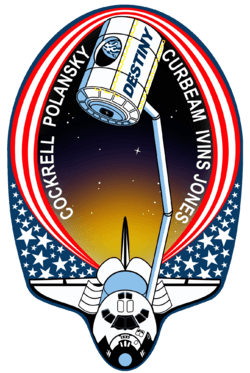  L-R: Robert Curbeam, Mark Polansky, Marsha Ivins, Kenneth Cockrell and Thomas Jones |
|
STS-98 was a 2001 Space Shuttle mission to the International Space Station (ISS) flown by Space Shuttle Atlantis. It was the first human spaceflight launch of the 21st century. STS-98 delivered to the station the Destiny Laboratory Module. All mission objectives were completed and the shuttle reentered and landed safely at Edwards Air Force Base on 20 February 2001, after twelve days in space, six of which were spent docked to the ISS.
Crew
| Position | Astronaut | |
|---|---|---|
| Commander | Kenneth D. Cockrell Fourth spaceflight |
|
| Pilot | Mark L. Polansky First spaceflight |
|
| Mission Specialist 1 | Robert L. Curbeam Second spaceflight |
|
| Mission Specialist 2 | Marsha S. Ivins Fifth and last spaceflight |
|
| Mission Specialist 3 | Thomas D. Jones Fourth and last spaceflight |
|
Launch attempts
| Attempt | Planned | Result | Turnaround | Reason | Decision point | Weather go (%) | Notes |
|---|---|---|---|---|---|---|---|
| 1 | 19 Jan 2001, 2:10:42 am | scrubbed | — | technical | 15 Jan 2001, 3:00 pm | rollback to VAB for booster separation cable inspection | |
| 2 | 7 Feb 2001, 6:11:16 pm | success | 19 days, 16 hours, 1 minute | 90% |
Mission highlights
The crew continued the task of building and enhancing the International Space Station by delivering the U.S. Destiny Laboratory Module. It was the first NASA lab to be permanently used since the days of Skylab nearly three decades earlier. It was manufactured by Boeing at the Michoud Assembly Facility and the Marshall Space Flight Center in 1997. Upon transport to Kennedy Space Center's industrial buildings, it was fitted with equipment, machines, racks and cables at the Operations and Checkout Building and Space Station Processing Facility. The U.S. laboratory module is 28 feet (8.5 m) long and 14 feet (4.3 m) wide. It is made from stainless steel and aluminum, and comprises three cylindrical sections and two end-cones that contain the hatch openings through which astronauts enter and exit the module. The ends are colored blue and white respectively for the crew to navigate easily. A 20-inch (510 mm)-diameter window is located on one side of the center module segment.
During the mission, the shuttle docked to PMA 3 located on the nadir of Node 1. The crew relocated PMA 2 to the holding area on the Z1 truss temporarily, before using the Shuttle's robotic arm to lift out the 14.5 ton steel module out of the Shuttle's payload bay, and permanently berthed it on the forward hatch of Node 1. Spacewalks conducted by Thomas Jones and Robert Curbeam reattached electrical cables to the stainless steel hull and connecting ports on Destiny, and also checked the laboratory's nadir window. PMA 2 was replaced to the forward hatch of Destiny.
The Shuttle spent six days docked to the station while the laboratory was attached and three spacewalks were conducted to complete its assembly. The mission also saw the 100th spacewalk in U.S. spaceflight history. STS-98 occurred while the first station crew was aboard the new space station.
Space walks
| EVA | Spacewalkers | Start (UTC) | End | Duration |
|---|---|---|---|---|
| EVA 1 | Thomas D. Jones Robert L. Curbeam |
10 February 2001 15:50 |
10 February 2001 23:24 |
7 hours 34 minutes |
| Jones and Curbeam went to the payload bay of Atlantis where they disconnected cables and removed protective covers from the outside hatch of Destiny. Once at the installation site and after Destiny had been securely installed, the pair began connecting power and data cables. | ||||
| EVA 2 | Jones Curbeam |
12 February 2001 15:59 |
12 February 2001 22:49 |
6 hours 50 minutes |
| The pair of spacewalkers went outside and assisted the robot arm operator with removing the Pressurized Mating Adapter 2 (PMA-2) from the Z1 Truss segment and installing it onto the forward end of the Destiny laboratory. Once that task was complete Jones and Curbeam moved to a location on the Destiny lab and installed a Power Data and Grapple fixture and video signal converter, to be used with the Canadarm2. | ||||
| EVA 3 | Jones Curbeam |
14 February 2001 14:48 |
14 February 2001 20:13 |
5 hours 25 minutes |
| During the third and final spacewalk, the two spacewalkers attached a spare communications antenna to the International Space Station's exterior. They also double-checked connections between the Destiny lab and its docking port, released a cooling radiator on the station, inspected solar array connections at the top of the station and tested the ability of a spacewalker to carry an immobile crew member back to the shuttle airlock. | ||||
Wake-up calls
NASA began a tradition of playing music to astronauts during the Gemini program, which was first used to wake up a flight crew during Apollo 15. Each track is specially chosen, often by their families, and usually has a special meaning to an individual member of the crew, or is applicable to their daily activities.
| Flight Day | Song | Artist/Composer | Links |
|---|---|---|---|
| Day 2 | "Where You At" | Zoot Sims | [] |
| Day 3 | "Who Let the Dogs Out" | Baha Men | [] |
| Day 4 | "Girl's Breakdown" | Alison Brown | [] |
| Day 5 | "Blue Danube Waltz" | Johann Strauss Jr. | [] |
| Day 6 | "Fly Me to the Moon" | Frank Sinatra | [] |
| Day 7 | "For Those About to Rock" | AC/DC | [] |
| Day 8 | "To the Moon and Back" | Savage Garden | [] |
| Day 10 | "The Trail We Blaze" | Elton John | [] |
| Day 11 | "Blue (Da Ba Dee)" | Eiffel 65 | [] |
| Day 12 | "Fly Away" | Lenny Kravitz | [] |
| Day 14 | "Should I Stay or Should I Go" | The Clash | [] |
See also
 In Spanish: STS-98 para niños
In Spanish: STS-98 para niños


